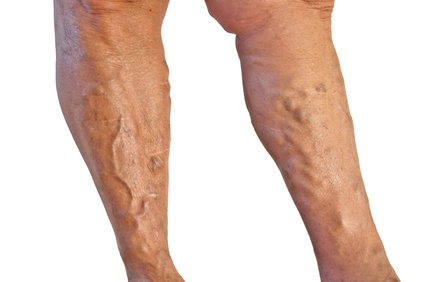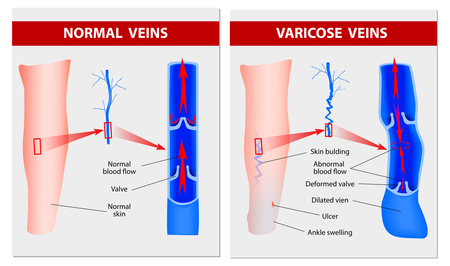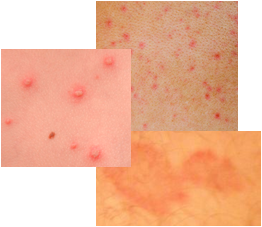Varicose Veins Causes
Visit this
PICTURES OF RASHES PAGE
Varicose veins and spider veins occur because the veins are abnormal and are defective or have been damaged and are not functioning properly. The role of veins is to return blood that is low in oxygen content, back to the heart and lungs so that it can be reoxygenated. In order for the oxygen poor blood from the lower part of the body to return to the heart, it must fight the forces of gravity.

The veins in the legs endure the most pressure as a result of this gravity effect. In order to not stress the heart too much because it has to fight the force of gravity, one-way valves are present in the veins. These values prevent the backflow of blood in the veins and therefore, the heart does not have to experience significant strain to pump the blood up the body.
The leg muscles are involved in helping move the blood back to the heart. Leg muscles squeeze the veins in the legs and feet causing the one-way valves to open. The heart pumps and blood flows up. The muscles then relax and release the pressure on the vein walls and the valves close. Because they are one-way valves the blood cannot flow back down the leg. When the heart pumps again, the whole process is repeated and eventually the oxygen poor blood reaches the heart and lungs for replenishment.
Varicose and spider veins occur when the one-way values are damaged and they are not able to stop the backflow of blood down the body or leg. As a result, blood pools in the area of the damaged valves and either spider veins develop or with more significant pooling, the veins swell full of blood and veins that are varicose will form.
Varicose Veins Causes
The above information explains why varicose and spider veins occur. However, what causes the vein valves to malfunction? What are the factors that make some individuals more likely to suffer from these vein problems? The answer is not simple because there are a wide variety of factors that make people prime candidates for these veins. Possible causes are listed below.

Age
As an individual gets older, he/she is more likely to suffer from varicose or spider veins. This can be simply due to the effects of all the wear and tear on the veins during an individual’s day-to-day life activities.
Gender
Although either men or women can develop spider veins or varicose veins, women are more likely to develop these problems.
Heredity
Problems with the veins such as weak vein walls, valves that are weak and more easily damaged, too few valves in the veins, or simply valves that do not function properly are all possible vein problems that can be inherited. They may exist at birth or develop as the individual ages. If an individual has family members with spider vein and varicose vein problems, then there is a good probability that he/she will also be afflicted with these problems.
Hormonal Changes
Hormonal changes that occur during puberty, pregnancy, and menopause can make individuals more susceptible to the development of varicose and spider veins. In addition, post-menopausal hormonal replacement therapy and the use of birth control pills can increase the risk of the development of problem veins.
Pregnancy
Varicose veins and spider veins may be more prominent or first appear during pregnancy. During pregnancy, the volume of blood in a woman’s body increases. This increased volume can lead to vein enlargement. The increase in size and weight of the uterus may also add an increase in pressure on the veins.
Hormonal changes during pregnancy, leading to the relaxation of the vein walls, add to increasing the risk of developing spider and varicose veins.
Often, problem veins as a result of pregnancy will disappear within one year after childbirth. However, with multiple pregnancies comes the increased risk of the problem veins becoming permanent.
In addition, during pregnancy hemorrhoids, which are essentially varicose veins around the anus, may form. Non-pregnant individuals may also develop hemorrhoids often if they are susceptible to varicose veins.
Obesity
A person that is obese is more likely to develop spider veins and varicose veins because the excess weight places too much daily pressure on the legs. Proper weight control will help prevent the formation of vein problems, especially in the legs. Proper exercise such as walking and running to improve leg muscle strength, circulation, and vein strength is also necessary for prevention.
Physical Effects
When an individual walks the leg muscles contract and are able to effectively act on the veins so that the venous pump works well. The venous pump is the whole process that involves muscles squeezing the veins, valves opening, blood flowing through the open valves towards the heart, leg muscles relaxing, and valves closing to prevent the backflow of blood.
However, prolonged sitting or standing without much movement causes blood to pool in the veins because the venous pump is not working efficiently. This pooling raises the pressure within the veins and if the individual is predisposed to a vein problem, the veins can stretch, which weakens the veins walls and damages the vein valves.
Sitting with the legs cross restricts proper circulation and increases the pressure in the veins, thus making an individual more susceptible to spider veins and varicose veins. Of course, individuals with normal healthy functioning veins can tolerate more pressure within the veins before problems develop. Eventually, even for these individuals, the veins will deteriorate due to the constant pressure on them.
Individuals with occupations that require prolonged standing such as beauticians, teachers, nurses, factory workers, etc. are at greater risk.
Physical exertion may also lead to spider veins or varicose veins. Chronic constipation, chronic cough, or any other activity or condition that causes chronic strain on the body and an increase in pressure in the leg veins, can led to the development of varicose or spider veins. Eat a fiber rich diet to prevent strain from constipation and treat other problems to avoid causing an increase in strain to the veins.
Elevating the legs when resting is great for relieving symptoms and lessening the pressure on the legs and can be a very effective prevention technique.
Sun Exposure
Too much exposure to the sun can lead to the formation of spider veins on the face. In particular, fair-skinned people are at greater risk. Affected areas are usually the cheeks or nose. When outdoors, appropriate sunscreen should be used to prevent the formation of sun induced spider veins.
Other Varicose Veins Causes
Complications
Chronic Venous Insufficiency
This is a varicose or spider vein problem that can lead to the problem of varicose eczema or venous ulcers. When there is poor blood flow in a certain area, then the method in which the skin is able to exchange oxygen, nutrients, and waste products with the blood is negatively affected. Over time, this poor exchange will lead to certain skin care problems.
Varicose eczema is a brown or purple discolouration of the skin, which can be permanent. A rash may also develop.
Venous ulcers will form when poor blood flow exists and there is not enough drainage of fluid from the skin. Because of the poor blood flow the ulcer does not heal and this condition can continue for a long time if no treatment is given. Fluid build-up can also lead to fungal and bacterial infections of the skin tissues when there is poor circulation. Venous ulcers can be treated with compression stockings or compression bandaging to improve the blood flow in the affected area or with surgery to remove to problem causing veins.
Phlebitis
Occasionally, these veins can form a blood clot that is referred to as phlebitis. This blood clot can be extremely painful and the skin may become red and swollen in the affected area. This blockage is associated with veins that are near the surface of the skin and is a less serious condition than the deep vein thrombosis problem.
Deep Vein Thrombosis (DVT)
In severe cases of varicose veins, vein thrombosis may develop. This condition is characterized by sudden and severe leg swelling. It is associated with blockages in deeper veins, unlike phlebitis. The clot causing the blockage can potentially travel to heart and lungs. Therefore, this is a serious condition that requires immediate medical attention.
Rupture of Veins
Varicose veins unfortunately can rupture leading to extensive bruising and possibly infection or several other complications. Extensive external bleeding can occur if the areas with varicose veins are cut. Treatment for this issue will likely require emergency medical attention and first-aid procedures for excessive bleeding such as elevating the wounded area above the heart and applying pressure to the wound to slow the bleeding.
Spider and varicose vein resources:
varicose veins | causes | treatments
